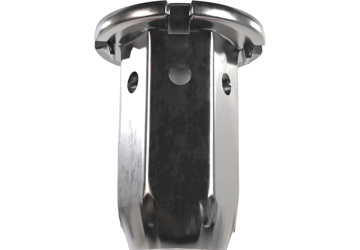

Here EJOT® focuses on its EJOT® DELTA CALC prognosis programme and how it can be used for the pre-dimensioning of direct fastening into thermoplastics.
The EJOT® DELTA CALC can offer valuable support for design engineers and developers as it can calculate, depending on the material and pilot hole dimension, the fastening parameters of the DELTA PT® screw.
The EJOT DELTA PT® screw (pictured above) is the high capacity fastening element for reliable and trouble free direct fastening into thermoplastic. A research programme based on the mechanical parameters of many thousands of applications and test assemblies has proven that reliable clamp load calculations are also possible for thermoplastic material (compared to VDI 2230). On this basis, the DELTA PT® geometry and the corresponding prognosis programme EJOT® DELTA CALC have been developed.
Based on the VDI 2230 many effective calculation programmes are available today, but their application range is limited to the calculation of metric screw joints in metallic materials. For the calculation of self-tapping joints in plastics, the guidelines of the VDI 2230 are not completely applicable. In particular the process of thread-forming and the specific material properties of thermoplastic material have not been considered. With the development of the DELTA CALC prognosis programme EJOT has addressed this problem in order to offer an optimum design aid to the customer. The result is an effective and precise calculation tool, which has already been proven in many applications and is also subject to ongoing optimisation and further development.
Brief characteristics of the possible applications of the EJOT® DELTA CALC prognosis programme include:
Design of the boss hole
For dimensioning of the boss hole the default DELTA CALC calculation applies the design guidelines of the EJOT DELTA PT®. In practice these specifications often vary. The effect of these variations can be simulated with the programme within realistic boundaries (see diagram 1). With a tied in material data bank a selection of approximately 150 different thermoplastics is available for the calculation of the joint.
Clamp load oriented design
The clamp load, the actual quality criterion of a screw joint, is the main parameter for the calculation with DELTA CALC. By specifying the clamp load and the mating and clamping material, a reliable calculation of the screw dimension and required tightening torque is possible, which is needed to safely reach the specified clamp load in a process reliable way. A reverse calculation, which means the specification of the tightening torque for determination of the clamp load, is also possible with DELTA CALC.
Calculation of the optimum assembly parameters
DELTA CALC is able to calculate (see diagram 2) different failure modes (e.g. stripping, screw fracture) and their occurrence (e.g. clamp load at stripping). With this knowledge it is possible to set the optimum installation parameters with the programme in order to minimise the risk for errors and guarantee a process reliable assembly.
Prognosis of the long term performance of a screw joint
The clamp load created by the tightening torque decreases due to the relaxation behaviour of plastic depending on time and temperature. With the indication of time and temperature the loss of clamp load can be prognosticated with DELTA CALC.
This and other functions for the precalculation of screw joints lead to a clear reduction of development time and thus significant costs savings in component design. With DELTA CALC these savings potentials can be recognised and used early in the process. Over dimensioning of the screw joint is prevented, material and thus weight is saved. Time consuming and cost intensive tests on the component are also reduced to a minimum.

Having spent a decade in the fastener industry experiencing every facet – from steel mills, fastener manufacturers, wholesalers, distributors, as well as machinery builders and plating + coating companies, Claire has developed an in-depth knowledge of all things fasteners.
Alongside visiting numerous companies, exhibitions and conferences around the world, Claire has also interviewed high profile figures – focusing on key topics impacting the sector and making sure readers stay up to date with the latest developments within the industry.





